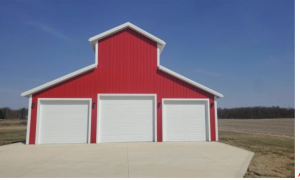Larimer County, Colorado
I drive through the Fort Collins area about once a year. Other than the urbanized areas, the terrain is a classic example of Exposure C for wind (for a “fun” wind exposure story read https://www.hansenpolebuildings.com/blog/2011/11/wind_exposure/ or to get more technical: https://www.hansenpolebuildings.com/2012/03/wind-exposure-confusion/).
 One of our clients had been discussing with Hansen Pole Buildings Designer Lily a pole building to be located in rural Larimer County. The county had provided him with a sheet of “prescriptive” requirements for non-commercial, non-residential pole barns in the county.
One of our clients had been discussing with Hansen Pole Buildings Designer Lily a pole building to be located in rural Larimer County. The county had provided him with a sheet of “prescriptive” requirements for non-commercial, non-residential pole barns in the county.
I’ve railed in the past about prescriptive requirements from Building Departments, so I might as well keep up my soapbox rant (visit my prior rant here: https://www.hansenpolebuildings.com/2012/02/prescriptive-requirements/).
For those who want to follow along, the Larimer County handout can be viewed at: https://www.larimer.org/building/pole_structure.pdf).
Let’s take a look at the “non-high wind” requirements.
Building is limited to 35 foot clearspan with engineered trusses. Columns are to be placed every eight feet. Footprint can be up to 3000 square feet. Maximum wind speed is 110 mph.
Now the catch in this is the statement in the handout, “All framing elements are to be designed in accordance with accepted engineering practice”. Which seems contrary to buildings utilizing the “basic handout design”.
With an eave height of 14 foot and a 4/12 roof slope, columns would need to be 6×10, IF diaphragm design is used, otherwise 6×12. I say “IF” because the handout makes no provisions for how to utilize diaphragm design.
In either case, all is well and good, except getting a solid sawn column larger than 6×6 in Colorado is a challenge unto itself.
The treated hold down cleat is not likely to provide sufficient resistance to uplift to resist 2512 pounds. A sophisticated engineering analysis would be required for proof. Read more about column uplift here: https://www.hansenpolebuildings.com/blog/2012/02/concrete-collars/
The 2×6 wall girts at 24 inches on center will work to carry the wind load (stressed to just under 96% of capacity), however deflection using the common framing lumber with a MOE (Modulus of Elasticity) of 1,300,000 is over in the deflection department by nearly 35%. It would take a MOE rating over 1,800,000 to meet the deflection requirements. (Read about girt deflection here: https://www.hansenpolebuildings.com/blog/2012/03/girts/)
The interior truss to column connection, must be able to withstand 4411 pounds of uplift force. Considering a Simpson Strongtie (https://www.strongtie.com/products/connectors/HRS-ST-PS-HST-LSTA.asp) HST2 7 gauge steel plate with six 5/8” diameter through bolts will only support up to 4835 pounds, it is not possible to imagine the two ½” carriage bolts (as specific in the handout) as being anywhere close to adequate.
To reiterate my basic premise: If a Building Department has PRESCRIPTIVE REQUIREMENTS for Pole Buildings – invest in an engineered building kit. It is less expensive to pay for the engineering and it guarantees a building which will be designed to actually meet the building codes!






